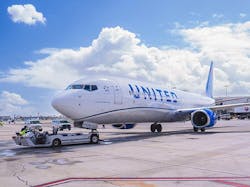United Airlines selects Honeywell to provide avionics on new 737 Max
CHICAGO - Commercial carrier United Airlines in Chicago needed avionics for its Boeing 737 Max aircraft entering service over the next decade. They found their solution from Honeywell in Phoenix. Honeywell will provide technology including 3D weather radar, new 25-hour flight data recorders, and advanced traffic avoidance systems.
United Airlines first selected a similar suite of Honeywell avionics in 2018 to equip 161 of its 737 Max aircraft, and this latest agreement builds on Honeywell’s reliability in delivering world-class aerospace technology.
“We are proud to continue our long-standing relationship with United Airlines to provide advanced avionics for its growing 737 Max fleet,” said Heath Patrick, President, Americas Aftermarket, Honeywell Aerospace Technologies. “Our technology reduces pilot workload, improves situational awareness, and supports dispatch reliability.”
Related: Honeywell demonstrates SURF-A runway incursion avoidance tech
Heath Patrick, President of Americas Aftermarket at Honeywell Aerospace Technologies, expressed pride in continuing the company’s long-standing relationship with United Airlines to provide advanced avionics for its expanding 737 Maxfleet. He emphasized that Honeywell’s technology is designed to reduce pilot workload, improve situational awareness, and enhance dispatch reliability.
United Airlines has chosen several Honeywell cockpit technologies for its 737 Max fleet. The IntuVue RDR-4000 3D Weather Radar System, the first automatic commercial radar to accurately depict weather in an airplane’s flight path, scans the sky at 17 tilt angles—more than any other system in the industry. It delivers a 3D view of the weather through an intuitive display that pilots can quickly and easily reference.
The Honeywell Connected Recorder-25 – 25 is designed for commercial air transport aircraft and accommodates mandatory flight data and cockpit voice recording. This recorder also has the potential to improve maintenance predictability and operational insight through data analytics. Additionally, Honeywell’s TPA100B Traffic Alert and Collision Avoidance System, along with the TRA 100B Transponders, help identify the aircraft to surrounding aircraft via an airborne collision avoidance system, enhancing safety.
The Integrated Multi-Mode Receiver is a leader in radio navigation technology, combining satellite- and ground-based systems into one receiver. This receiver aids in pinpointing precise airplane locations for efficient landings, particularly during difficult or new runway approaches. Finally, the ALA-52B radar altimeter supports instrument landings at hundreds of U.S. airports and is designed to filter out interference from 5G broadband.
About the Author
Jamie Whitney
Senior Editor
Jamie Whitney joined the staff of Military & Aerospace Electronics in 2018 and oversees editorial content and produces news and features for Military & Aerospace Electronics, attends industry events, produces Webcasts, and oversees print production of Military & Aerospace Electronics.
